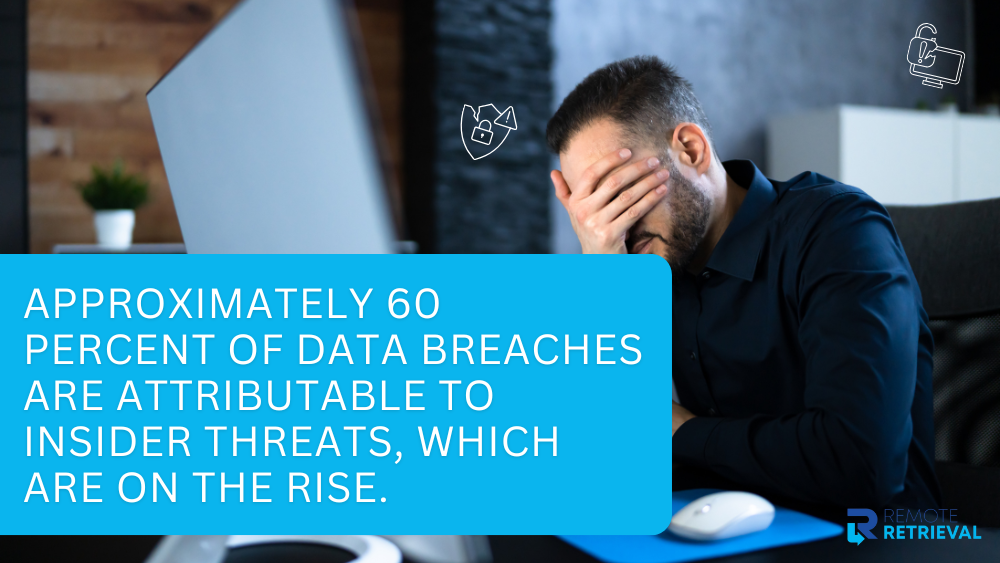Image Source: iStock/Visual Generation
When an employee leaves a company, most people think about handovers, farewell emails, and final paychecks. But in today’s remote work environment, security is yet another part of offboarding that’s far more critical. With laptops, access credentials, and sensitive data spread across home networks, the risk of insider threats has quietly grown. Sometimes it’s a displeased former employee walking away with company files. Other times, it’s simply delayed action, like a device not retrieved in time, or an account left active a little too long. Either way, the result can be costly.
The shift to remote and hybrid work has made retrieving company-owned equipment more complex and essential. A forgotten laptop or an unsecured return isn’t just an operational hiccup but an open door to potential data leaks. This is where timely, structured, and proper laptop retrieval plays a crucial role. It helps companies close those gaps before small oversights turn into big problems.
Sign Up for Remote Pickup of Your Equipment!
The Insider Threat Problem in Remote Offboarding
When we talk about insider threats in the context of remote offboarding, it’s easy to imagine an unhappy employee with malicious intent, but the reality is broader, quieter, and often more overlooked.
Here’s what we mean by “insider threats” in this setting:
-
An employee who deletes or copies sensitive company data to a personal device before handing in their laptop and leaving the company.
-
A former staff member whose access to internal systems, accounts, or credentials hasn’t been fully deactivated, leaving a room open for weeks after they’re gone.
-
A laptop still sitting in someone’s home or a family member using it, where company files remain accessible and vulnerable to accidental exposure or misuse.
What’s important to stress is that many of these threats aren’t rooted in malice. They often stem from inefficient retrieval processes, delayed deactivation of devices/users, or poor coordination between HR, IT, and operations teams.

Approximately 60 percent of data breaches are attributable to insider threats, which are on the rise. Another study found that 83% of organizations reported at least one insider attack in the last year.
By reframing retrieval not just as a logistical step, but as a security control, companies can close a critical gap in their remote-work offboarding process.
Where the Offboarding Process Fails
Even companies with well-documented procedures can stumble when it comes to remote offboarding. The mix of distributed teams, multiple systems, and human error leaves plenty of room for small oversights that turn into real cybersecurity risks. In many cases, insider threats don’t happen because someone wanted to cause harm; they happen because the offboarding process left cracks wide open.
-
Delayed Retrieval
When a company laptop sits uncollected for days (or worse, weeks) after an employee’s departure, it creates a dangerous gap in control. That device may still hold sensitive files, cached passwords, or active system access. Even if the person who left has no ill intent, delayed retrieval keeps company data out of sight and outside company control for too long. The longer a device remains in limbo, the higher the risk of accidental leaks or misuse.
-
No Verification
Collecting a laptop is one thing; verifying what’s on it is another. Many companies accept returned devices without confronting whether data has been backed up, wiped, or locked. Without this verification, sensitive information may remain recoverable on the hard drive, putting your organization at risk of a future data breach. A foolproof IT asset recovery plan ensures every device is logged, inspected, and securely reset before being redeployed.
-
Soiled Teams
Offboarding touches multiple departments; for instance, HR manages the employee exit, IT handles access deactivation, and logistics oversees equipment return. When these teams don’t communicate effectively, key steps fall through the cracks. A delay in one area can create exposure in another. Aligning these departments with shared timelines and automated notifications helps close those risky gaps.
-
Poor Tracking
It’s surprisingly easy for companies to lose sight of who has what device, especially when managing hundreds of remote employees. Without a centralized tracking system, equipment can go missing, be forgotten in storage, or stay with an ex-employee indefinitely. This lack of visibility not only wastes resources but also increases security exposure. Reliable asset tracking ensures accountability from deployment to retrieval.
Sign Up for Remote Pickup of Your Equipment!
How Retrieval Plays a Preventive Role
Retrieval shuts down one of the most overlooked security risks in remote work. A well-managed retrieval process acts as a first line of defence against data breaches, insider misuse, and compliance failures. When handled with full visibility, it transforms offboarding from a potential vulnerability into a point of control and assurance.
-
Rapid Collection

Time is everything in security. The faster a company retrieves its devices, the shorter the window for data exposure or unauthorized access. Swift retrieval ensures that sensitive information, cached passwords, or stored credentials don’t remain accessible to anyone outside the organization. A streamlined pickup system helps companies recover assets within days, not weeks, keeping devices (and the data inside them) firmly under company control.
-
Chain of Custody

Once a device leaves an employee’s possession, it needs to travel securely and traceably. A clear chain of custody ensures that every handoff is logged, verified, and protected from tampering. With secure pickup, packaging, and delivery protocols, the right service provider maintains accountability at every step so businesses always know where their assets are and who’s handling them.
-
Device Inspection

Retrieval doesn’t end when the laptop returns; it continues with verification. Inspecting each device ensures that it’s functional, free of unauthorized data, and ready for reuse or recycling. Immediate locking or secure wiping upon receipt protects against any residual risks. This proactive inspection is what turns retrieval from a logistical step into a cybersecurity safeguard.
-
Process Automation

Automation bridges the gaps that human oversight can leave behind. Integrated tracking systems automatically alert HR, IT, and security teams the moment a device is collected or received. This coordination keeps offboarding aligned and ensures nothing slips through the cracks.
-
Audit Trail

Compliance and accountability depend on documentation. A robust retrieval process leaves behind a digital paper trail that records every step, from pickup to inspection to data wipe. This audit trail not only satisfies regulatory requirements but also provides evidence in case of future security reviews or investigations. This transparency builds trust and ensures total control over company assets.
Best Practices for Secure Remote Offboarding
A secure offboarding process protects your organization’s data, assets, and reputation long after an employee leaves. By tightening coordination between teams, streamlining retrieval, and integrating automation, companies can transform offboarding from a weak spot into a well-controlled security checkpoint. Here’s how to make it work:
1. Create Joint HR + IT Workflows
Offboarding shouldn’t be handled in isolation. HR teams can benefit from laptop return service to manage the employee exit, but IT holds the keys to data access and equipment control. When these departments operate on a shared checklist or workflow, key actions happen in sync, like deactivating accounts or scheduling retrieval. Regular communication ensures no one assumes the other team has “handled it.” This coordination prevents unnecessary delays and strengthens overall security.
2. Schedule Retrieval Before the Final Day
Remote offboarding requires well-planned execution. The safest approach is to arrange device retrieval before or on the employee’s final working day. This way, the company ensures the laptop and any other assets are securely collected before credentials are revoked. It removes the awkward post-exit chase and significantly narrows the risk window where data remains exposed.
3. Maintain a Device Inventory Dashboard
Visibility drives accountability. Keeping an updated dashboard or asset management system helps track which employee has which device, when it was deployed, and when it’s due for return. A centralized inventory prevents lost assets and simplifies retrieval coordination, especially for teams managing hundreds of remote employees across different regions.
4. Automate Credential Revocation and Retrieval Tracking
Automation eliminates the human lag that often leads to risk. Linking your HR and IT systems allows for automatic alerts when an employee is offboarded, triggering account deactivation and device retrieval workflows. Likewise, automated tracking notifications let teams monitor every step of the retrieval process in real time, from pickup to verification.
5. Partner with a Trusted Retrieval Provider
Finally, even the most efficient internal processes need reliable execution. Partnering with a professional retrieval service, like Remote Retrieval, ensures assets are collected quickly, securely, and with full documentation. From chain-of-custody handling to data verification, a trusted partner adds an extra layer of protection and peace of mind, allowing internal teams to focus on what they do best.
Sign Up for Remote Pickup of Your Equipment!
Laptop Retrieval Services vs. In-House Logistics: Which One Makes More Sense?
As remote and hybrid workforces grow, companies must decide how to handle the return of laptops and other assets once employees leave. There are two main approaches: managing retrieval internally or outsourcing it to a professional service provider. Both have advantages and challenges, and the right choice often depends on your company’s size, resources, and risk tolerance.
Let’s weigh the pros and cons of laptop retrieval services vs. in-house logistics.
In-House Retrieval
This approach means your internal HR, IT, or operations teams coordinate every step of the retrieval process, from contacting the departing employee and arranging shipping labels to confirming receipt and wiping data.
Pros:
-
Full control over the entire process and communication.
-
It can be cost-effective for smaller teams or local operations.
-
Easier to customize retrieval policies according to internal workflows.
Cons:
-
Resource-intensive, especially for larger or distributed teams.
-
Higher risk of delays, lost devices, or inconsistent follow-up.
-
Limited access to secure transport, chain-of-custody documentation, and verification.
-
Often lacks automation and visibility once devices are in transit.
Laptop Retrieval Services
These are professional providers that specialize in recovering, tracking, and processing company-owned laptops and IT assets. They manage everything from secure pickup to data verification and final delivery or disposal.
Pros:
-
Fast, structured retrieval with secure handling and documentation.
-
Chain-of-custody tracking and audit trails for compliance.
-
Frees internal teams from logistical and operational work.
-
Scalable across multiple locations or countries.
Cons:
-
Involves an additional cost compared to in-house management.
-
May require coordination or integration with existing HR/IT systems.
-
Slightly less direct control over day-to-day retrieval actions.
In short, in-house retrieval offers control but demands time and coordination, while professional services bring speed, security, and scalability. For most growing or fully remote companies, outsourcing retrieval strikes the right balance between efficiency and risk management—keeping devices and data protected from start to finish.
Sign Up for Remote Pickup of Your Equipment!
Final Words
In remote work, the offboarding process is as critical as hiring. Each unreturned or delayed laptop creates a small but serious security gap. By making retrieval a core part of cybersecurity with quick collection, clear tracking, and coordinated workflows, companies protect both data and reputation. Whether managed internally or through a trusted partner like Remote Retrieval, the goal is the same: ensure every device is securely recovered and accounted for. When that happens, offboarding becomes not a risk, but a reflection of strong operational control.
